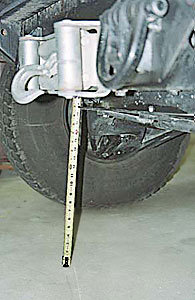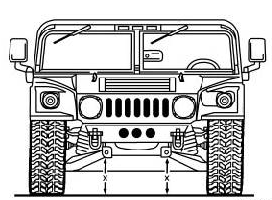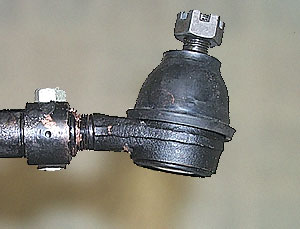Springs
Updated February 28, 2015
I'm in the parking lot of the Best Western in Ouray Colorado when John Ward (AMG tech rep) says "Is that your truck over there?". I say "yea, why". He says "you need front springs. Tell them to put on the heavy duty winch springs". Over the last five years I've heard on and off that some owners had problems with sagging springs so I wasn't surprised. My truck's been to Moab, South Dakota, New Mexico and Colorado and has done it's share of bouncing around.
Before you blame your springs it might well be worth your time to first check your lower control arms where the coil springs nest for a broken-out/caved-in section. Trucks that have been exposed to salt water and road salt can rust the arms until the springs push down through the bottom.
I procrastinated on the whole deal and a couple of months later I started to feel a shake in my front end between 60 and 65 mph. I figured that the wheels needed balancing so I took them in to a shop on the North side of Chicago where we checked the wheels for trueness as well as balance. This didn't cure the vibration so I brought the truck back and we checked the wheels again. What we did find were worn tie rod ends. I decided as long as I was going to do the tie rods I might as well bite the bullet and replace the springs too.
 I wanted to make sure that the springs were really out of spec so I latched onto the AMG service bulletin 96-09-01 regarding the settling of front springs.
I wanted to make sure that the springs were really out of spec so I latched onto the AMG service bulletin 96-09-01 regarding the settling of front springs.
"The bulletin is to advise dealers of acceptable front suspension height for Hummer vehicles. It is in response to field reports of sag or lean".
It goes on to say that there are other causes that can contribute to low suspension height such as damaged or broken frame or suspension components, worn out front end parts, low front tire pressures, parking on an incline or crowned road surface and extremely heavy load placed on the front of the truck.
Your spring height is critical to alignment. Spring height will affect your caster and camber. As the springs sag the camber goes negative (wheels splay out). If it's bad enough there won't be enough adjustment in the cams (98 and newer trucks) to overcome the negative caster.
The following is the procedure used to measure the front suspension height of a Hummer.
SUSPENSION HEIGHT MEASUREMENT

- Check tire pressure, front tires should be at 26 psi and rear tires at 28 psi, curb weight.
- Ensure that tires and rims are original equipment as supplied by AM General. This means GSA's, MT/R's or MT's.
- Position vehicle on level surface.
- Remove any load from vehicle interior or from roof rack. Tools, luggage, recreational equipment, or similar items may produce faulty measurements if left in the vehicle.
- Jounce vehicle front and rear 2-3 times and allow suspension to settle.
- Check suspension height by measuring distance between bottom edge of each lower control arm front cross member bracket and shop floor as indicated by dimension "X".
Springs are acceptable if height measured at each side is 16 inches (40.6 cm) or greater and left-right measurements do not differ by more than 3/4 inch (19 mm). Replace springs only if height measured is less than 16 inches at either side, or if right-left variation exceeds 3/4 inch (19 mm).
Note: Always replace coil springs in sets even when only one spring is affected.
I measured my ride height and found it to be around 14.5 inches. AMG makes 3 kinds of springs for our Hummers. Hummers with the factory Warn winch come standard with the winch springs. All the others have the regular springs. If you're going to install a snow plow the heavier plow springs are available. I've talked to guys that put the Plow springs on and they ride too hard so only use them if you need to. I have a Mile Marker winch which is much lighter than the factory Warn. I installed the stock factory winch springs and got a measurement of 18".
The standard civilian rear spring is a progressive rate spring. It rides
soft when the truck is lightly loaded, but still will hold up the rear if
the truck is loaded.
There are two other springs available for the rear, and if you spend
most of your miles with a heavy load, it makes sense to switch to a
non-progressive spring. Over time, the light section of the progressive
spring will compress, lowering the rear a bit.
As of August 2011 the price for one regular front spring is 196 and one winch spring is 369 from AMG so it's not an inexpensive repair.
AM General Spring Application Chart
| Compiled by Chuck Kopelson; 1/5/2001 | |||||||
| Part Number | Type | GVWR | Application | Rate lbs/in | Tie Color | Wire Dia | Free Height |
| 12338316 1B2 | Standard Front | 10,300 | 2door W/O winch or plow | 954 | Yellow | 13.36" | |
| 12338316 1B9 | Standard Front | 10,300 | W/O winch or plow | 954 | Yellow | 13.36" | |
| 6005786B9 | Standard Front | 10,800 | W/O winch or plow | Blue | |||
| 06005786B2 | Front | 10,300 | Winch | 1250 | Orange | 0.989 | 13.36" |
| 06005787 B2 | Front | 10,300 | Note: 1 | 954 | Red | 14.0" | |
| 12338316-2 Note: 2 |
Front | 10,800 / 12,100 | Snow plow | 1728 | Green? | 1.052 | 12.36" |
| RCSK1842 81B9 | H/D Front | 12,100 | Fire trucks | Note: 3 | Natural | ||
| 12338316 B2 | Rear | 10,300 | 10,300 | Variable | Grey | ||
| 06006008 B2 | Rear | 10,300 | 10,800 | 2,300 | Blue | ||
| 06011073 | Rear | 12,100 | 12,100 H/D | 3,000 | Yellow & Red | ||
Note 1: 2 door pickup W/ winch or other vehicles without winch or equipment on front of vehicle.
Note 2: Old part number is 12338316 2B2 or 06011072
Note 3: Different spring perches have to be installed
Note 4: HMMWV spring part numbers are recessed into the flat area (top of spring when installed). You may need to do a little scraping to read it.
Note 5:Old part number is 12338316 2B9
Another Spring Chart 
How Your Suspension Works and Why Spring Spacers are Problematic
The first thing you have to understand is how the suspension is supposed to work. The springs absorb the shock, not the shock absorber. When the spring compresses it has to release. The job of the shock is to dampen this release (absorb the spring energy) so the spring releases smoothly and doesn't continue to travel up and down; oscillate (twang). Why is this bad? The idea is to have your tires on the ground with weight on them for traction and steering ie handling. If you hit a bump and the front end is bouncing up and down you will loose some control. Then when the rear wheels hit the same bump a split second later the interaction between the two cause unpredictable handling.
If you are off road and crawling along at 2 mph and hit a big dip your heavy engine laden front end will go down and compress the spring. Then it will rise up and come out of the hole throwing all that weight up in the air. This is where the shocks and the springs are doing their work. If your shocks are working correctly you will have a controlled rise. I remember this happening many times on the Moab UT trails.
A lot of engineering went into the hummer as well as a lot of practical debugging by the military. There are many ramifications when you make changes in the suspension. If you have ever hung around when you truck is getting aligned you will realize how exacting this all is. Tuesday I had my 98 aligned. It took 4 hours to get it right using an experienced tech on a new Hunter machine. This is a truck with the newer cam system.
Every time the spring height changes you change the front caster / camber and the rear camber. When the camber changes the toe changes. The Hummer suspension is designed to travel a set amount. The CV joints in the half shafts are only designed to operate at a certain angle. The tie rod ends and ball joints are designed to operate and wear correctly if used within a certain travel as are the shocks.
Installing spring spacers or taller springs just makes the truck sit higher toward the extended part of it's travel. What this does is bias the suspension travel toward the high side. When you hit a dip you will go in and compress the spring. As you rise out of the hole the spring and shock will already be extended to the max and hit the stop in the shock. This will negate what your suspension is designed to do and eventually beat the shock to death. Race trucks actually have cables tied between the suspension and frame to keep the arm from dropping below it's limit especially if the truck is airborne over a jump.
Air Bag Springs
I guess air bags are OK, but there several things that are never taken into consideration when using them.
Generally speaking, the front end will never again be in perfect alignment and will wear tires like crazy.
Most guys will want to go for the extra height when 4 wheeling the truck and that will put extra amounts of load and stress on the CV joints of the Half Shaft, and they will probably break quite a few before the figure out that they are going beyond the angle limits of that part.
The shocks must be made specifically to fit the truck with the correct extended and compressed length to handle the new travel lengths, and there are no shocks made in the large bore, which is required on the H1 to withstand the abuse they'll get, unless you order some special length Rod Hall shocks at $1600 each, and they are a built as a position sensitive unit which will not align properly or work in all regimes of the suspension, when the suspension height is variable as with air bags.
In addition, because of the varied height of the suspension, the handling and cornering is going to change due to alignment change, and could produce some serious over/understeer situations. Any time the spring height changes it changes the caster and camber angles.
I know that guys have done this, and as long as they do it themselves, there's no liability expressed or implied by someone's business, but one of these days, someone is going to get severely hurt in an accident and some slick lawyer is going to collect a bundle.
Now, if it's an off road only machine, all the above is not as important liability wise, but you still have a change in the handling, the Half Shaft problem, and the shock problem.
Rod Hall Springs
The reason I called Chad Hall is that I heard the Hall front and rear springs are a better spring than what you can get from Amg and they last alot longer. Chad did tell me that the rear buckets would have to be changed out to the military style, and the front and the rears would be the same load rating about 4300 lb's. Any insight to this would be helpful. Also if you are running the Hall springs have you noticed any more wear on the ball joints or the front drive line parts???
Response:
Better than AMG parts? Probably not - at least for a factory truck.
Different from AMG parts? Yes. The Fronts aren't anything special - stick
with stock.
The rears are definitely different - and better for off-road use. Not if
you want to carry two tons in the back however - you would squish these
flat. The rears are constant rate, without the cargo carrying capacity of
the factory series - but much more comfortable off-road in that you get
more flex, you don't get rear spring push off bumps at high-speeds (where
the rear of the truck comes down fast off a bump, compresses the factory
heavy rate cargo section - which then rebounds and pushes the rear of the
truck into the air).
I have had three sets of these in two trucks - I have never replaced the
spring hats with military ones. Perhaps this is a new requirement? News to
me anyway. I am on my second set of rears on my Slantback - the first set
eventually sagged and were not replaced under warranty, despite Chad
telling me at the time I bought them that they wouldn't ever sag.
I like the springs for the additional flex, the lack of spring hop, and the
additional clearance (adds about 1" over the factory setup). I haven't
noticed any change in wear to ball joints or steering components.
Considering the price for a set of rears is similar to a factory set, it
was a no-brainer for me.


Here's what brand new winch springs and tie rod ends look like. The upper and lower tie rod ends are threaded differently. One has left hand threads, the other right. The tierod end part 6011887 is a Right Hand thread. 6011886 is a left hand thread. The center section is called the sleeve. The tie rods have a 7/8-18 bolt/pitch with a 5/8" center eye. Many of the suspension parts were upgraded around 1995. Here is the AMG bulletin.
 The tierod on the left is a newer design with an offset. These came out because the older straight joints bound up under extreme suspension flex.
You can freely mix and match these without a problem.
The tierod on the left is a newer design with an offset. These came out because the older straight joints bound up under extreme suspension flex.
You can freely mix and match these without a problem.
The new tie rod ends are slightly longer than the straight ones. When you buy a new complete tie rod you get a shorter sleeve - center section. If you have the angled steering arm covers, you can use the longer (older) sleeve with the new ends. The latest sleeves have a groove at each end to hold the clamp in the proper position at the end.
The left hand thread tie rod is originally installed on the outer end with the right hand on the inner side. You can reverse these on the front so verify the part when ordering a replacement.
Both rear radius rods have left hand tierod ends on the outside. The rear tierod ends are the same part as the front left handed threaded part.
Second Page of Article
